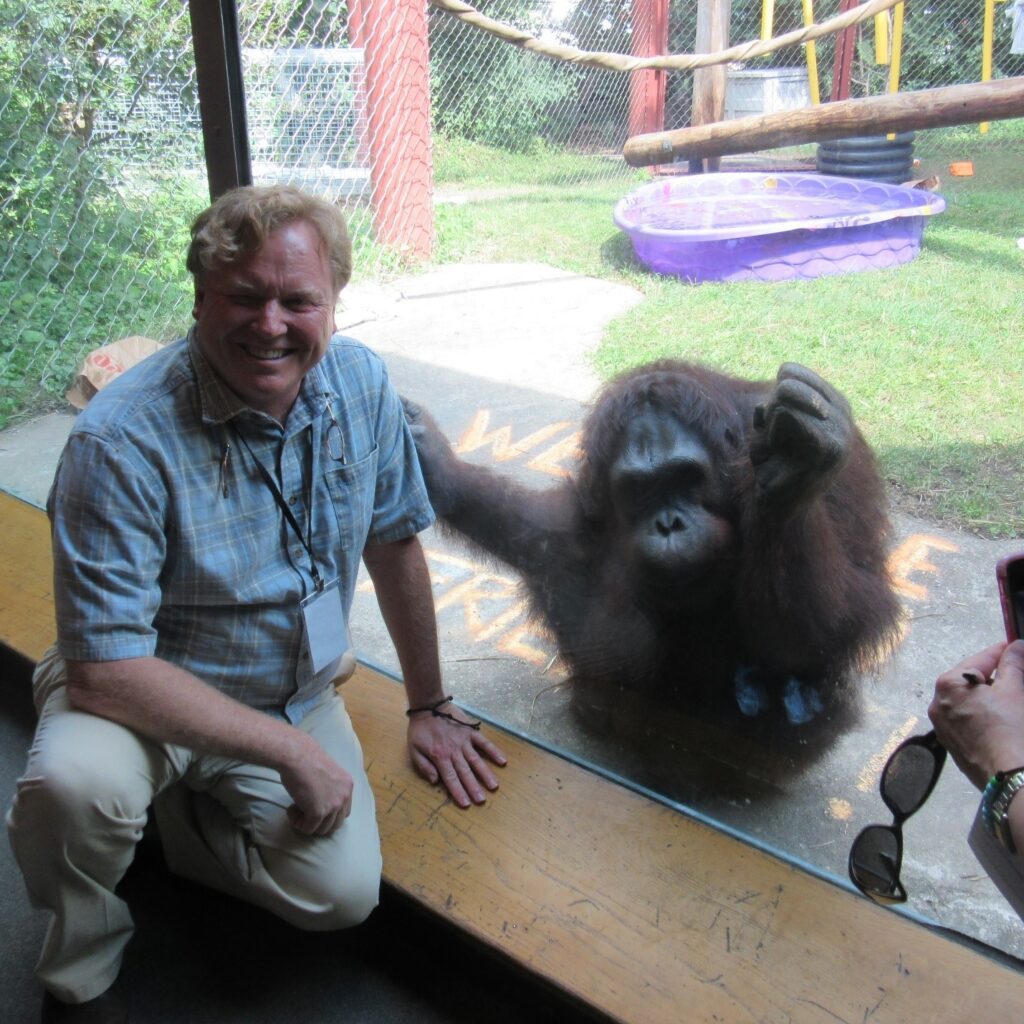Species Survival Plans (SSPs) are cooperative animal management and conservation programs for endangered species in zoos and aquariums in North America; Seneca Park Zoo participates in many SSPs for endangered species, including orangutans. In August, I was fortunate enough to attend the annual Orangutan Species Survival Plan conference along with the Zoo’s Director of Animal Health and Conservation Dr. Jeff Wyatt. The conference was hosted by The Henry Vilas Zoo in Madison, Wisconsin.
Like Seneca Park Zoo, the Henry Vilas Zoo is home to Bornean orangutans. The male is Datu, who is the son of Kumang and her previous mate, Lowell. Datu was born here at Seneca Park Zoo in 2004, and in 2011 he was sent to Henry Vilas Zoo for recommended breeding with Kawan. During his time here in Rochester, Datu formed close relationships with his keepers and with Dr. Wyatt, who has maintained positive relationships with the orangutans by visiting them frequently just to say hello or to participate in a training session, making his veterinary work less intrusive.Part of the conference included a visit to the Henry Vilas Zoo. Dr. Wyatt was looking forward to seeing Datu, whom he hadn’t seen in years. When our group arrived at the orangutan exhibit, there was Datu, sitting in the grass, not paying particular attention to any of the visitors. That changed as soon as he heard Dr. Wyatt’s voice. Datu sat straight up and zeroed in on where the voice was coming from. He moved right up to the front of the exhibit, staring at Dr. Wyatt.
Dr. Wyatt was so happy to see that Datu remembered him, and the people around us were amazed at the strong reaction he had. After a few moments of Dr. Wyatt speaking in a friendly voice to a totally engaged Datu, we moved inside to the viewing glass. Datu of course followed, and when Dr. Wyatt kneeled down at the glass, Datu came right up and greeted him by rubbing his shoulder on the glass at him, similar to what a cat might do. Datu then put his hands on the glass and sat face to face with Dr. Wyatt. It was a very touching moment for them both as well as everyone watching.
Dr. Wyatt was able to spend about 20 minutes hanging out with Datu before reluctantly leaving to catch a flight, but it was obvious this visit meant a lot to both of them, and I’m so glad I was there to see it.There’s something special about orangutans: they are so similar to us in so many ways. Not just because we share 97% of the same DNA, but because like us, they also have moods, emotions and their own personalities and thoughts. As zoo professionals, we learn not to treat the animals we care for as pets, but there are often close bonds formed with these animals when you work for them and care for them on a daily basis. I’ve seen and experienced many examples during my career, but the one I saw between Dr Wyatt and Datu is my most memorable one by far.The keynote speaker at the Orangutan SSP conference this year was Dr. Graham Banes, a noted field researcher, genetic researcher, and an expert on orangutans in general. Dr. Graham spoke on several topics, but the one that had the most impact on me was the story he told of his visits to China. He was hired by the Chinese government as a consultant for a proposed DNA research lab, and being an animal person, he started visiting any and every Chinese zoo he came could find. Dr. Banes found that Chinese zoos were somewhat behind the times compared to most zoos elsewhere in the world. Digging a little deeper, he found out why.
Due to China’s lack of free flowing information via the internet or in printed form, they have not been able to benefit from the collaboration between zoological institutions which has led to increasingly better conditions for animals worldwide during the last several decades. Dr. Graham started to form relationships with the zoo directors he met and advised them on how they could improve conditions in their own zoos. His enthusiasm and love for animals no doubt helped inspire Chinese zoo officials to do better, and they have started to make some real progress.Dr. Graham informed us that after our conference he was heading back to China for a meeting with 122 zoo directors from all over China to discuss enrichment ideas, especially those zoos that exhibited orangutans–at least 20 by his count. He asked us to send him any interesting orangutan enrichment videos he could share with the Chinese. I have some footage of our three orangutans working away with sticks at their “termite mound” (I usually use sugar free jello!) and I sent it to him the next day. Dr. Graham got back to me and said he really liked the video; do I have any details on how to build one? Our termite mound was built for us as an Eagle Scout project, and we used detailed plans provided by the Honolulu Zoo on their website. I sent him the link so he could copy the plans, he thanked me and headed off to China the next day.–Brian Sheets, Zoo Keeper








